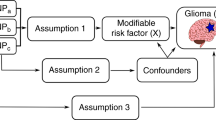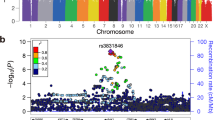Abstract
Genome-wide association studies have recently identified a cancer susceptibility locus at 10p12 mapping to MLLT10 associated with the onset of diverse tumors. We genotyped two tightly linked single-nucleotide polymorphisms (SNPs) at MLLT10 associated with meningioma (rs12770228) or ovarian cancer (rs1243180), and tested for associations among 295 meningioma cases, 606 glioma cases and 646 noncancer controls, all of European descent. The variant ‘A’ allele in MLLT10 rs12770228 was associated with an increased risk of meningioma (per allele odds ratio: 1.25; 95% confidence interval: 1.02, 1.53; P=0.031). Similar associations were observed for rs1243180. MLLT10 variants were unrelated to glioma. Functional investigation identified 22 candidate functional SNPs mapping to this region. The present study further validates 10p12 as a meningioma risk locus.
Similar content being viewed by others
INTRODUCTION
Meningioma is a poorly understood tumor arising in the membranous layers surrounding the central nervous system, the meninges. Although only very rarely fatal, these tumors may cause substantial morbidity. Female gender, African ancestry and exposure to ionizing irradiation are well-established risk factors.1, 2, 3 Several familial syndromes are associated with an increased incidence of meningioma and other nervous system tumors4, and genetic susceptibility is also documented in these tumors.5 In a recent genome-wide association (GWA) study (859 meningioma cases and 704 controls in the discovery phase),5 a region localizing to 10p12.31 was identified as harboring risk variants for meningioma. The initial signal came from a single-nucleotide polymorphism (SNP) (rs12770228) mapping 40 kb 5′ of MLLT10 (encoding myeloid/lymphoid or mixed lineage leukemia translocated to 10) and lying within the 3′-untranslated region of the predicted transcript C10orf114. An extended region of association was identified within the LD block encompassing MLLT10, with an imputed SNP (rs11012732) reported to provide the best evidence for the association signal at the 10p12.31 locus. Of interest, the same region was subsequently implicated in a GWA study of epithelial ovarian cancer (EOC)6 in which an intronic variant in MLLT10 (rs1243180) located in the same LD block as the meningioma risk alleles was demonstrated to confer an increased risk across the spectrum of EOC subtypes. MLLT10 encodes a transcription factor and is known to participate in chromosomal rearrangements that result in various leukemias. However, the studies of Dobbins et al5 and Pharoah et al6 are the first indication that MLLT10 may contribute to other forms of cancer. To shed further light on the 10p12.31 locus in relation to cancer risk, we genotyped risk variants at the MLLT10 locus in a US case-control study of primary brain tumors.
MATERIALS AND METHODS
A description of the study population has been published.7 Briefly, brain tumor cases were individuals aged 18 and older with a recent diagnosis (within 4 months) of meningioma or glioma identified in neurosurgery and neuro-oncology clinics at medical centers in the Southeastern United States. Controls were persons sampled from communities giving rise to the cases with no personal history of brain tumor and frequency matched to the cases on age, gender, race and state of residence, supplemented with friends and non-blood relatives of the cases. Meningioma cases, glioma cases and controls were similar in median age (54, 52 and 55 years, respectively) and proportion graduating high school (91%, 89% and 96%, respectively), whereas an excess of the glioma cases were male (62%) and of the meningioma cases, female (72%), consistent with incidence patterns of these tumors in the population. Oral genomic DNA was available for all subjects. Study protocols were approved by the institutional review committees at each participating center and all study participants provided written informed consent.
Genotyping was attempted for a total of 295 meningioma cases, 606 glioma cases and 646 noncancer controls, all of European ancestry. TaqMan assays (Applied Biosystems, Foster City, CA, USA) were successfully designed for variants linked to meningioma (rs12770228) and ovarian cancer (rs1243180), whereas a second variant linked to meningioma (rs11012732) failed at the design stage. Laboratory personnel were masked to the case-control status of the samples. Genotype frequencies among controls were in Hardy–Weinberg equilibrium for both of the genotyped SNPs. LD relationships for the three MLLT10 variants are shown in Table 1.
Genotype associations were examined using unconditional logistic regression and statistical significance evaluated using the Wald test.
RESULTS
Results are shown in Table 2. Variant alleles in both of the genotyped SNPs were associated with an increased risk of meningioma with statistically significant associations observed under an additive and recessive model of inheritance. Persons homozygous for the variant ‘A’ allele in rs1243180 had an ∼80% increased risk of meningioma when compared with persons homozygous for the wild-type ‘T’ allele. Similar results were observed for rs12770228. Minor allele frequencies (MAFs) were identical in glioma cases and noncancer controls (MAFs: 0.31 and 0.33 for rs1243180 and rs12770228, respectively). Associations were unchanged after restricting analyses to noncancer controls (not shown). Neither variant was associated with the risk of glioma: the per minor allele odds ratios (OR) for rs12770228 was 0.97 (95% confidence interval (CI): 0.82–1.15; P=0.70) for all gliomas, and 0.94 (95% CI: 0.77–1.15; P=0.54) after restricting to advanced-stage tumors (glioblastomas) comprising ∼60% of the case group (not shown). MLLT10 locus genotypes were also unrelated to survival times in patients with glioblastomas (not shown): the per minor allele hazards ratio for rs12770228 was 0.96 (95% CI: 0.80–1.14; P=0.61) for all patients, and 0.97 (95% CI: 0.79–1.20; P=0.78) restricting to patients treated with the currently accepted standard of care for these tumors,8 after controlling for age and gender. Similar null results were obtained for rs1243180.
In order to identify candidate functional SNPs in the risk region, all SNPs in high LD (arbitrarily set at r2≥0.6) with at least one of the two input SNPs (rs12770228 and rs1243180) were retrieved using SNAP proxy search.9 We identified a total of 104 SNPs within this region meeting the LD criterion. These ‘LD SNPs’ spanned an ∼500-kb region from C10orf114 through DNAJC1. To assess the functional significance of these SNPs, each was examined using RegulomeDB,10 which scores SNPs according to their location within known or predicted regulatory elements. Of the 104 SNPs, only 13 had a RegulomeDB score of 4 or lower, indicating evidence of at least one transcription-factor binding site and one DNase I hypersensitivity peak at the input coordinate. As regulatory elements have been shown to be cell specific, we also plotted all 104 SNPs and determined whether they overlapped with available ENCODE data for FAIRE (Formaldehyde-Assisted Isolation of Regulatory Elements)-Seq in brain cell lines. This analysis revealed that an additional 9 of the 104 SNPs may have functional significance, specifically in brain cells. Thus, a total of 22 functional candidate SNPs were identified within the region, all non-coding (Supplementary Table). Interestingly, both the input SNPs (rs12770228 and rs1243180) appeared as potential regulatory SNPs. The majority of the candidate functional SNPs fell within a 150-kb region from C10orf114 through the 5′ region of MLLT10 (Supplementary Figure 1A). The remaining top-scoring SNPs were within a 70-kb region of the DNAJC1 gene (Supplementary Figure 1B). On the basis of our preliminary analysis, we believe these 22 SNPs are the strongest functional candidates within the region.
DISCUSSION
The present study confirms reported associations of variants at the 10p12.31 locus with the risk of meningioma among persons of European descent. Applying a conservative Bonferroni adjustment assuming 12 tests (2 SNPs × 2 diseases × 3 hereditary models) with a P-value cutoff of 0.00417 (0.05/12), results for rs12770228 in meningioma are statistically significant in the recessive model in spite of the stringent threshold applied. The two genotyped variants are in high linkage disequilibrium with one another, and with a third variant (rs11012732) that reportedly produced the strongest signal at this locus in the GWA study of Dobbins et al5 that was not typed in the present study. The per minor allele OR in the present study for rs12770228 (OR=1.25) is somewhat less prominent than that reported by Dobbins et al (OR=1.39 combining German, UK and Scandinavian study populations) though MAFs among controls were similar in the two studies (0.31 and 0.32, respectively). There was evidence that a recessive model may best describe the biological relationship of causal variants at this locus (yet to be determined) given null findings among heterozygotes; future studies and a larger series of cases are needed to formally test this hypothesis. Finally, we report that variants at the MLLT10 locus are unlikely to alter risk of glioma, the most common and malignant subtype of brain tumor, and they have no prognostic value among patients with high-grade tumors (glioblastoma). A total of 22 candidate functional SNPs may be of further interest in future functional analysis of this region.
References
Wiemels J, Wrensch M, Claus EB : Epidemiology and etiology of meningioma. J Neurooncol 2010; 99: 307–314.
Braganza MZ, Kitahara CM, Berrington de González A, Inskip PD, Johnson KJ, Rajaraman P : Ionizing radiation and the risk of brain and central nervous system tumors: a systematic review. Neuro Oncol 2012; 14: 1316–1324.
Kohler BA, Ward E, McCarthy BJ et al: Annual report to the nation on the status of cancer, 1975-2007, featuring tumors of the brain and other nervous system. J Natl Cancer Inst 2011; 103: 714–736.
Farrell CJ, Plotkin SR : Genetic causes of brain tumors: neurofibromatosis, tuberous sclerosis, von Hippel-Lindau, and other syndromes. Neurol Clin 2007; 25: 925–946.
Dobbins SE, Broderick P, Melin B et al: Common variation at 10p12.31 near MLLT10 influences meningioma risk. Nat Genet 2011; 43: 825–827.
Pharoah PD, Tsai YY, Ramus SJ et al: GWAS meta-analysis and replication identifies three new susceptibility loci for ovarian cancer. Nat Genet 2013; 45: 362–370.
Egan KM, Thompson RC, Nabors LB et al: Cancer susceptibility variants and the risk of adult glioma in a US case-control study. J Neurooncol 2011; 104: 535–542.
Stupp R, Hegi ME, Gilbert MR, Chakravarti A : Chemoradiotherapy in malignant glioma: standard of care and future directions. J Clin Oncol 2007; 25: 4127–4136.
Johnson AD, Handsaker RE, Pulit SL, Nizzari MM, O'Donnell CJ, de Bakker PI : SNAP: a web-based tool for identification and annotation of proxy SNPs using HapMap. Bioinformatics 2008; 24: 2938–2939.
Boyle AP, Hong EL, Hariharan M et al: Annotation of functional variation in personal genomes using RegulomeDB. Genome Res 2012; 22: 1790–1797.
Acknowledgements
Financial support was received from Public Health Service Grants R01CA116174 and R25T CA147832 (Dr Baskin) from the National Cancer Institute, National Institutes of Health, Department of Health and Human Services and institutional funding from the Moffitt Cancer Center, Tampa, FL and the Vanderbilt-Ingram Comprehensive Cancer Center, Nashville, TN.
Author information
Authors and Affiliations
Corresponding author
Ethics declarations
Competing interests
The authors declare no conflict of interest.
Additional information
Supplementary Information accompanies this paper on European Journal of Human Genetics website
Supplementary information
Rights and permissions
About this article
Cite this article
Egan, K., Baskin, R., Nabors, L. et al. Brain tumor risk according to germ-line variation in the MLLT10 locus. Eur J Hum Genet 23, 132–134 (2015). https://doi.org/10.1038/ejhg.2014.70
Received:
Revised:
Accepted:
Published:
Issue Date:
DOI: https://doi.org/10.1038/ejhg.2014.70
This article is cited by
-
Mitochondrial DNA sequence variation and risk of meningioma
Journal of Neuro-Oncology (2021)
-
Methylmercury exposure, genetic variation in metabolic enzymes, and the risk of glioma
Scientific Reports (2019)
-
Longer genotypically-estimated leukocyte telomere length is associated with increased meningioma risk
Journal of Neuro-Oncology (2019)



